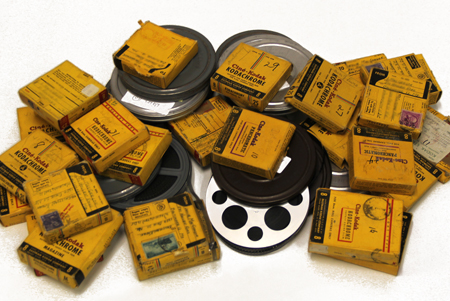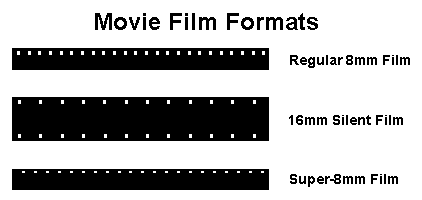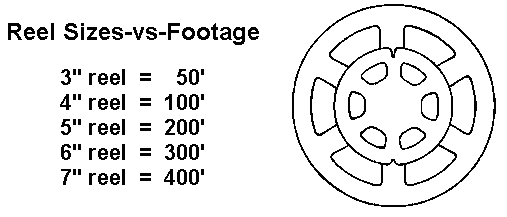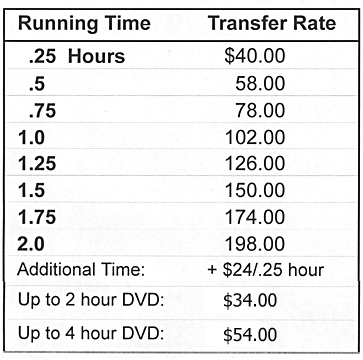|
|
Regular 8mm and Super-8mm Movie Film
Before we explain our film to DVD or film to digital transfer procedure, perhaps a brief discussion of just what home movie film consists of is in order.
The majority of home movie films will be in the Regular 8mm and/or Super-8mm
category. That means the actual width of the film measured
from side to side if laid flat on a table will be 8mm's wide or approximately 3 tenths of an inch. Both 8mm and Super-8mm film may have the same width but that's where the similarity  ends. Super-8mm, the full name for S8mm, was invented by Eastman Kodak in 1965 as a way to invigorate the lagging home movie market. Gone were the days where you had to wind the film through the camera by hand to load it. The new film format meant entirely new cameras that took a fast loading plastic 50' cartridge. By making the size of the sprocket holes much smaller Kodak was able to enlarge the size of the picture frame by 50%. Bigger picture together with better and faster film stocks all meant a sharper, brighter picture on the screen. The home movie market took off like never before. ends. Super-8mm, the full name for S8mm, was invented by Eastman Kodak in 1965 as a way to invigorate the lagging home movie market. Gone were the days where you had to wind the film through the camera by hand to load it. The new film format meant entirely new cameras that took a fast loading plastic 50' cartridge. By making the size of the sprocket holes much smaller Kodak was able to enlarge the size of the picture frame by 50%. Bigger picture together with better and faster film stocks all meant a sharper, brighter picture on the screen. The home movie market took off like never before.
The older 8mm format, also called Regular 8mm so as not confuse it with Super-8mm, came out way back in 1935. It was offered up as a less expensive method of shooting movies than it's big brother, 16mm. In actuality, the unexposed 8mm film went into the camera as 16mm width film. The reel was loaded with about 25 feet of 16mm wide film that you had to thread through the camera and onto the empty take up spool. You exposed the first side of the film then opened the camera again to reverse the films direction so you could expose the second half of the reel. After the film was developed, it was slit down the middle and the ends spliced together to give you the final 50 feet of, what was now, 8mm wide movie film.
The most common Regular 8mm film format was a color film known as Kodachrome followed later by Kodachrome 40. Kodak was the largest and most well known manufacturer of 8mm movie film but there were many other companies that also made and processed movie film. Kodak had Kodachrome processing facilities around the country. Customers had the option of mailing in their films directly or going through a local camera or department store that may have been a Kodak dealer.
 This chart shows the three film formats that were used for shooting home movies in the United States. There were other formats that existed overseas but these formats were standard in the US. The middle format, 16mm, was first introduced in the early 1920's. It was the first "safety film" introduced by Eastman Kodak meaning it did not have the propensity to catch fire like 35mm nitrate film stock used in the movie theaters at the time. This was followed by Regular 8mm film in 1932 and Super-8mm film in 1965. After your film had been developed by Kodak or some other processing lab it would have been returned to you on a metal or plastic projection reel. The 8mm and S8mm movies would have come back on three inch reels containing 50 feet of film. In the case of 16mm, four inch reels holding up to 100 feet of film were the most This chart shows the three film formats that were used for shooting home movies in the United States. There were other formats that existed overseas but these formats were standard in the US. The middle format, 16mm, was first introduced in the early 1920's. It was the first "safety film" introduced by Eastman Kodak meaning it did not have the propensity to catch fire like 35mm nitrate film stock used in the movie theaters at the time. This was followed by Regular 8mm film in 1932 and Super-8mm film in 1965. After your film had been developed by Kodak or some other processing lab it would have been returned to you on a metal or plastic projection reel. The 8mm and S8mm movies would have come back on three inch reels containing 50 feet of film. In the case of 16mm, four inch reels holding up to 100 feet of film were the most  common although there did exist smaller camera loads of only 50 feet. The larger reels shown in this chart refer to the additional size reels you could have obtained at your local camera shop. Many movie camera buffs would take the time to "edit" their films and, in doing so, wind up the smaller loads onto larger reels for a longer, uninterrupted viewing experience. It is not uncommon to see a mixture of reel sizes when you go through your home movies to get them in order for transfer to digital. common although there did exist smaller camera loads of only 50 feet. The larger reels shown in this chart refer to the additional size reels you could have obtained at your local camera shop. Many movie camera buffs would take the time to "edit" their films and, in doing so, wind up the smaller loads onto larger reels for a longer, uninterrupted viewing experience. It is not uncommon to see a mixture of reel sizes when you go through your home movies to get them in order for transfer to digital.
How to compute the cost to transfer Regular 8mm and/or Super-8mm film to a DVD or digital format:
In
this section, we will deal only with Reg. 8mm and Super-8mm film to DVD transfers. We have a page just for 16mm if you happen to have some of that, as well. The pricing is a bit higher for 16mm so we have kept that separate to make things easier to understand.
Computing your costs is a simple process. Your original 8mm and/or Super-8mm film will
more than likely be on any of three reel sizes. The most common is the
3" 50 foot reel. This is the size reel your home movies would have come back on from the film laboratory after they were processed. If your family was
into editing and assembling their movies they may have wound them up onto 5" 200 foot or possibly even 7" 400 foot
reels for a more uninterrupted viewing experience. You will need to
add up the footage of the various size reels for each format, keeping the 8mm separate from the Super-8mm for the time being, to come up with a total for each, if you have both.
Next, divide the total film footage for each format by the amount of film in one hour. In other words, divide by 680 for your Reg. 8mm film and by 856 for your Super-8mm. Add those figures together to get the total amount of transfer time for your home movie films. The chart, below, allows you to compute the cost of the film transfer. Remember to number your reels in the order you wish to have them transferred putting the 8mm first followed by any Super-8's.
To make things even easier for you we have an info packet you can download as a PDF file. All the pricing and order information will then be available in printed form for you to go over at your leisure. The forms you will need to send in with your film are also there. If there are ever any questions, please feel free to call us anytime and we will go over any of your concerns with you on the phone. We want you to feel assured and confident you are sending your priceless home movie films to a service you can trust.

The transfer process:
Our normal procedure is to transfer to raw mpeg2 direct from the telecine system into one of our servers. From there the various reel segments are edited and combined into a final, fully authored DVD. This DVD becomes your master. It is advisable to order at least one duplicate set made from the master(s) and keep the master set with your films. In addition to the DVD set you will also be supplied with a thumb drive of the fully edited digital file along with access to a digital download of the completed transfer for you to install on your smart phone or tablet. This gives you complete convenience no matter where or how you elect to view your film transfers.
Remember, these rates are inclusive of all services and supplies to get your film in shape for the transfer. We do not charge you extra for inspection, film reels, leader, splices or cleaning solution. The charge you see is the charge you can expect to pay based, of course, on the total amount of film you actually have, in 1/4 hour increments. This factor, alone, sets
us apart from most other film transfer services out there. Many will impose additional charges for the 400' plastic reels used to assemble your smaller reels before the transfer as well as charge for splicing and cleaning your film. The special anti-static and anti-fungal film cleaner we use costs us over $100 per gallon!
Apple ProRes Film Transfers (for professionals and advanced amateurs):
For customers who require the highest possible image quality, because they may be doing additional editing and/or post-production, we can supply your transfers using the Apple Quicktime ProRes codec. Apple ProRes 422 is a high quality, lossy video compression format developed by Apple.
It requires that you have Apple Final Cut Pro or iMovie for the Mac. There is also a low-cost program called Mojave that will edit ProRes on the PC. You will need to supply a fully formatted, wiped USB hard drive to us with your film. The drive will be formatted using exFAT, which is compatible with both the PC and most recent Mac machines,
unless you have already done so. There is a charge of $20 to cover the cost of the backup and housekeeping for this service.
This web site is Copyright © 2006 - 2020 TFG Film & Tape, All Rights Reserved.
This site or any of its contents may not be copied or mirrored on any other web site or
used in any document, printed or electronic, without the express permission of this site's owner.
If you find certain wording or phraseology used above to explain our work or services on other
web sites please know it has been pilfered from us and is a clear violation of our copyright.

We offer film to DVD transfers to customers in Connecticut as well as around the country. In order to accomplish a proper film transfer of 8mm to DVD you need to use a facility that has the right equipment and experience. TFG Transfer is that facility. When you are ready to transfer your 8mm and super-8mm home movies to digital you need to contact TFG Transfer, Connecticut's source for film to DVD conversions and transfers using a telecine to convert movie film to DVD is the correct way to convert or transfer film to digital in Connecticut, when converting film to a DVD the exposure, density and color needs to be corrected frame by frame and using a telecine system allows for that at a reasonable price, why not have your films converted to digital file or DVD using a system that will give you the best quality, all the splicing of smaller 50' reels will be done at no extra charge when you use our transfer service, keep your memories alive and preserve them for the future by converting your movies to digital DVD at TFG Transfer in Hartford New Haven Westport Connecticut
|
|
|

